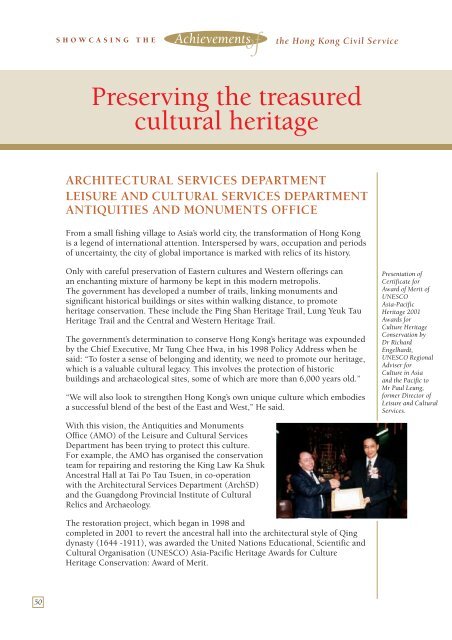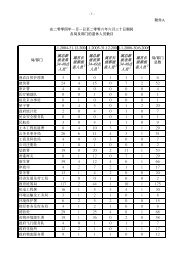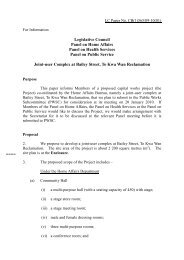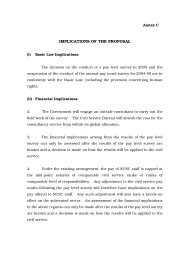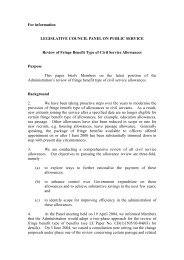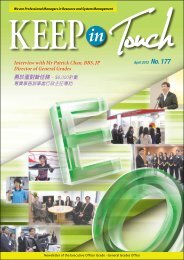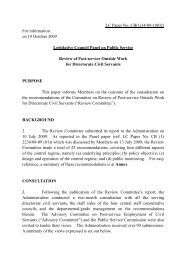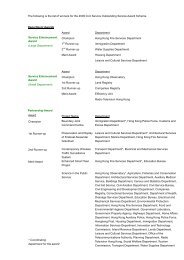Preserving the treasured cultural heritage
Preserving the treasured cultural heritage
Preserving the treasured cultural heritage
You also want an ePaper? Increase the reach of your titles
YUMPU automatically turns print PDFs into web optimized ePapers that Google loves.
<strong>Preserving</strong> <strong>the</strong> <strong>treasured</strong> <strong>cultural</strong> <strong>heritage</strong>Bringing <strong>the</strong> <strong>treasured</strong> monument to <strong>the</strong> publicThe panel of judges for <strong>the</strong> award commented with appreciation:“The outstanding restoration and preservation of <strong>the</strong> King Law Ka Shuk ancestral hallsets an example in <strong>the</strong> application of best practice methodology of renovation and indemonstrating <strong>the</strong> value of restoration and conservation of an historic building forcommunity use.”“Carried out through a balanced conservationapproach and strong community involvement,<strong>the</strong> restoration was an ambitious extrapolation tobring <strong>the</strong> ancestral hall to its original state,also integrating some of <strong>the</strong> modern elements from<strong>the</strong> 1930s.”The Certificateof Award of Meritof UNESCOAsia-PacificHeritage 2001Awards forCulture HeritageConservation.Assistant Curator of <strong>the</strong> AMO, Mr Ng Chi-wo,said: “We are very proud that such an authoritative organisation has recognised ourgovernment’s concern for <strong>cultural</strong> <strong>heritage</strong>.Chief Architect (Central Management Branch) of <strong>the</strong> ArchSD Mrs Priscilla Tamagreed, saying: “We are honoured to have contributed to <strong>the</strong> meaningful projectand have protected a cherished trace of Hong Kong’s history.”She said: “The monument was built in early 1700s and has been restored manytimes. All that remains of <strong>the</strong> first structure such as <strong>the</strong> traditional grey brick walls,timber brackets, <strong>the</strong> ancestral altar, timber carving and <strong>the</strong> plastered decoration arecarefully preserved.Traditionalcraftsman restores<strong>the</strong> decoratedplaster surface.“Identifying and recollecting <strong>the</strong> original design and buildingmaterials to restore <strong>the</strong> building posed a great challenge bothartistically and historically.”Mr Ng said <strong>the</strong> most difficult task was to reconcile <strong>the</strong>requirements of <strong>the</strong> architects with those of clan members and<strong>the</strong>re were times when “feng shui” was used to resolve somematters which were of particular concern to clan members.Impact of <strong>the</strong> project on <strong>the</strong>communityOwned by <strong>the</strong> Tang Clan, <strong>the</strong> ancestral hall atTai Po Tau Tsuen, was originally built tocommemorate <strong>the</strong> clan’s 10th generation ancestorTang King Law.The altar of KingLaw Ka Shukancestral hall afterrestoration.The hall was constructed as a study hall forteaching and preparing clan members for <strong>the</strong>important imperial examinations. With <strong>the</strong>government’s program of building primary andsecondary schools in <strong>the</strong> territory, <strong>the</strong> educationalfunction of <strong>the</strong> building ended in 1948.It was also a village meeting hall and a ceremonialhall to honour <strong>the</strong> clan’s ancestors.51
<strong>Preserving</strong> <strong>the</strong> <strong>treasured</strong> <strong>cultural</strong> <strong>heritage</strong>Careful redecoration of <strong>the</strong> main altar, which was of utmost religious importance,especially justified <strong>the</strong> hard work of <strong>the</strong> AMO and <strong>the</strong> ArchSD by <strong>the</strong> admiration offellow clansmen living in o<strong>the</strong>r villages.“The hall has now reverted to its former use as a central celebration venue fortraditional village functions,” Mr Ng said. “It is also an attraction for <strong>the</strong> emigratedTang clan members for making visits to <strong>the</strong>ir home village.”Left: King Law KaShuk ancestral hallbefore renovation.Right: King Law KaShuk ancestral hallafter restoration.Dedicated to conserving <strong>cultural</strong> <strong>heritage</strong>Besides <strong>the</strong> winning project of King Law Ka Shuk, Hong Kong also won UNESCOAsia-Pacific <strong>heritage</strong> awards for <strong>the</strong> restoration projects of Hung Shing Temple atKau Sai Chau, <strong>the</strong> Ohel Leah Synagogue and <strong>the</strong> Catholic Ca<strong>the</strong>dral of <strong>the</strong>Immaculate Conception.Hong Kong’s <strong>heritage</strong> items are a testimony to her unique past. Conserved <strong>heritage</strong>also forms part of Hong Kong people’s collective memory and defines <strong>the</strong>ir <strong>cultural</strong>identity. There is a growing recognition of <strong>the</strong> importance of <strong>heritage</strong> conservationin urban development and an increasing commitment by <strong>the</strong> community tosupport <strong>the</strong> government to conserve our <strong>heritage</strong>.Conservation of <strong>the</strong> former pumping station of <strong>the</strong> Water Supplies Departmentin Shanghai Street, and some of <strong>the</strong> buildings in <strong>the</strong> St Joseph’s Home for <strong>the</strong> Agedas well as <strong>the</strong> Lui Seng Chun Building at Sham Shui Po are landmark examples.The triumph of conserved <strong>heritage</strong> was seen again inFebruary, 2004, when <strong>the</strong> government reached a consensuswith <strong>the</strong> Church of Jesus Christ of Latter-Day Saints aftera year of negotiations on <strong>the</strong> preservation of <strong>the</strong> historicKom Tong Hall building.Kom Tong Hall,built in 1914,will be convertedinto a museumto introduceDr Sun Yat-sen,one of <strong>the</strong> mostrespected figures inHong Kong history.The hall was built in 1914 as a residence of <strong>the</strong> affluentHo Kom-tong, younger bro<strong>the</strong>r of Sir Robert Ho Tung.Built in <strong>the</strong> classical style architecture of <strong>the</strong> Edwardianperiod, <strong>the</strong> building is lavishly decorated with stained glass windows, teakwoodstaircase and panels. It was bought by <strong>the</strong> church in 1960 for religious purposesand will be converted, for permanent preservation, into a Dr Sun Yat-sen Museumin close vicinity with <strong>the</strong> Sun Yat-sen Historical Trail.52


